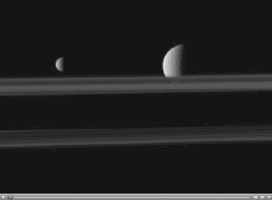
Click on the image for the animationThe small moon Mimas passes in front of the larger moon Rhea, which is partly obscured by Saturn's rings, in this movie from NASA's Cassini spacecraft.
Observations of mutual moon-crossing events, in which one moon passes close to or in front of another, help scientists refine their understanding of the orbits of Saturn's moons. This movie is a concatenation of 10 still images obtained over a span of about 6 minutes. The images were re-projected to a uniform view and computer interpolation was used to smooth the moons' motions between the frames.
In this video, Mimas (396 kilometers, 246 miles across) moves in front of the rings. Rhea (1,528 kilometers, 949 miles across) reveals the delicate separations within the rings as the thin line of the F ring appears before the backdrop of the mid-southern latitudes of the moon. Mimas travels at an average speed of 14 kilometers per second (31,000 mph). Rhea's average speed is about 8 kilometers per second (18,000 mph).
(For other movies like this one, see PIA11692 and PIA11693.)
In this view Rhea, at a distance of approximately 2.7 million kilometers (1.7 million miles), is farther from Cassini than Mimas. Mimas is closer to the spacecraft at a distance of approximately 2 million kilometers (1.2 million miles).
This view looks toward the northern, sunlit side of the rings from just above the ringplane.
The images were taken in visible light with Cassini's narrow-angle camera on Oct. 19, 2009. The view was obtained at a Sun-Mimas-spacecraft, or phase, angle of 95 degrees. Scale on Mimas is 12 kilometers (7 miles) per pixel.
The Cassini-Huygens mission is a cooperative project of NASA, the European Space Agency and the Italian Space Agency. The Jet Propulsion Laboratory, a division of the California Institute of Technology in Pasadena, manages the mission for NASA's Science Mission Directorate, Washington, D.C. The Cassini orbiter and its two onboard cameras were designed, developed and assembled at JPL. The imaging operations center is based at the Space Science Institute in Boulder, Colo.
For more information about the Cassini-Huygens mission visit http://saturn.jpl.nasa.gov/. The Cassini imaging team homepage is at http://ciclops.org.

